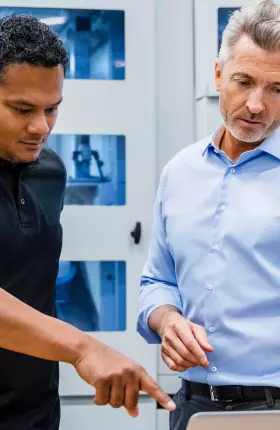CEOs are going all in on customer experience, prioritizing better, faster, more seamless interactions between the company and those it serves. And little wonder: for a long time, “new and improved” meant competitive advantage. But as more businesses put more focus on CX and get better at it, your company will be in good company. If you want to transcend expectations—and bask in that edge—you need to do more than step up your customer experience. You need to future-proof it.
The rewards can be substantial. A 2022 BCG survey found that businesses that lead on customer experience create more value, generate more growth, and foster more trust than their peers—by eye-opening margins. Leaders saw 55% higher five-year TSR growth, 190% higher three-year revenue growth, and 70% higher net promoter scores.
But what does this elevated, better-than-before and better-than-the-competition, experience look like? And what sort of capabilities, processes, even mindset does a company need to achieve and continually improve it? To find out, we looked at what CX leaders are doing to keep leading—and what resonates with customers. This analysis helped us zero in on five principles for future-proofing the customer experience. Together, they can help companies deliver the kind of innovative, adaptable, differentiated experiences that drive value for the long term.
Five Principles for Great CX
Companies that excel in customer experience tend to share certain characteristics. They create end-to-end customer journeys and use them to guide their CX practices and effort. They innovate to deliver breakthrough improvements, adopt and foster a customer-first mindset, and synchronize personalized interactions across touchpoints. Crucially, they relentlessly measure the impact of everything they do, so they can adjust course quickly and effectively. But to truly future-proof CX, you need to apply these capabilities in support of the following five principles:
- Meet immediate needs in a seamless and speedy way, removing all friction and barriers from the customer’s experience.
- Differentiate to drive value, leveraging new technologies, innovations, and partnerships to stand out in a crowded market.
- Create a human and emotional connection with the customer, building excitement, brand advocacy, and loyalty.
- Anticipate needs—even before the customer— and respond quickly to change (whether it’s a shift in customer behavior or in market dynamics).
- Prioritize sustainability and social impact, integrating them with the customer experience instead of treating them as add-ons.
Future-proofing means excelling at all five, but reaching that goal can take different paths. Many companies do a great job at removing complexity from customer interactions but have yet to experiment with new technologies or create deep connections with their customers. Others may design for resilience but aren’t fulfilling their customers’ immediate needs as seamlessly as they could. The five principles therefore can serve as a diagnostic, enabling companies to see how they stand on future-proofing—and direct their efforts and resources accordingly.
To help guide the way, we looked for indicators of maturity: practices and behaviors shared by companies that lead on specific principles. By assessing how they stack up, businesses can better understand the strengths they can leverage—and the gaps they need to close.
1. Meet Immediate Needs in a Seamless and Speedy Way
Today, it’s table stakes: make it easier for customers to interact with you, whether they want to buy a product, pay a bill, or schedule a doctor’s appointment. Yet while many companies do a good job at reducing complexity, doing a great job—making the experience as seamless as possible—requires some sophisticated capabilities. Chief among them is a deep understanding of the customer, along with the ability to use that insight to optimize interactions and, in turn, value.
Companies that do this in a best-in-class way align business strategy and customer experience—and structure KPIs accordingly. By tracking CX metrics, they can track progress toward business goals and adjust course as needed. Indeed, CX leaders regularly include these metrics in board discussions and earnings releases.
While many companies do a good job at reducing complexity, doing a great job—making the experience as seamless as possible—requires some sophisticated capabilities.
Another key enabler: orchestrating data. By bringing together data from across the organization, CX leaders develop a single 360-degree view of the customer: transactions, preferences, online behavior, and so on. That big-picture view—fueled by data governance that ensures it’s accessible, up to date, and accurate—informs decision making, letting companies better understand and meet needs. For example, consider an online retailer that sees that you regularly buy laundry detergent. It sends you an offer for its subscription delivery service, which will automatically provide you with detergent every month. You no longer need to remember to log on and place the order to have clean clothes. That’s a better, more seamless experience.
CX leaders also use data to map the end-to-end customer journey. Understanding that journey is crucial, as it can serve as a beacon across the organization, helping all employees, in all functions, articulate CX goals and their role in achieving them.
2. Differentiate to Drive Value
As companies get better at removing friction from interactions, seamlessness—while crucial—becomes less of a competitive advantage. So what else can you do to stand out from the crowd? CX leaders are constantly exploring new technologies, touchpoints, and partnerships, identifying ways to pull these levers to provide more value to the customer. And they’re not afraid to experiment. Indeed, they ingrain that mindset in their culture.
Consider, for example, how companies like Amazon, Ikea, and Sephora are using augmented reality to help consumers better visualize products. AR features are letting customers “try on” different types of makeup or see how a table will look and fit in their living room. The technology is helping companies provide an experience—and value—that many competitors are not.
Our analysis revealed some interesting and perhaps surprising insights into how CX leaders identify paths to differentiation. For one thing, they look beyond their own backyard. Analyzing what competitors are doing—as well as venture trends in your market—can shed light on how new developments propel customer experience, but it can also lead to “me too” features and services. Looking to where companies and investors in other sectors are placing bets can spark greater differentiation.
CX leaders also look at technology through a customer lens, instead of implementing capabilities simply because they’re possible. This lets them focus where it matters most: creating value for the customer and, in turn, for the company.
3. Create a Human and Emotional Connection
Future-proofing CX means delivering experiences that not only satisfy but delight: creating excitement, advocacy, and loyalty. Companies that excel forgo one-size-fits-all solutions. They understand that customers have individual journeys shaped by their unique needs, preferences, and mindsets. And they build on this understanding with interactions that feel personal and relevant, so customers feel that the brand really knows them.
Take Spotify, for instance. In suggesting songs to listeners, it not only looks at what a customer has listened to in the past but also considers factors like the music’s context (is the playlist for a party or a workout, for example?), the time and day (is it a weekend or a weekday?), and whether the listener is mobile or on a desktop. The idea is to recommend music that fits the customer’s preferences and circumstances.
Future-proofing CX means delivering experiences that not only satisfy but delight: creating excitement, advocacy, and loyalty.
Creating a human and emotional connection is not simple. It requires companies to look beyond traditional segmentation to uncover the mindset, lifestyle, and broader circumstances of individuals. Luckily, there are powerful enablers that help companies zero in on what matters to, and resonates with, each customer.
CX leaders invest in human-centered design and employ its techniques, such as engaging customers in the design process, to better understand the emotions that come into play and respond accordingly. They unleash data and AI to reveal the differences between customers and create more personalized experiences. And they know that creating and reacting to this deeper, more nuanced understanding of their customers is a dynamic process. So CX leaders continually test, learn, and iterate—in an agile way—to ultimately deliver the best solutions for each customer.
4. Anticipate Needs and Respond Quickly to Change
You can’t future-proof without looking ahead. But just as important, you need the capability to respond, quickly and precisely, to what you see. As the world shifts with greater speed—and often greater volatility—that resilience is increasingly crucial.
CX leaders don’t have a crystal ball, but they do have some sophisticated approaches and enablers for anticipating a customer’s next need, even if that customer may not yet know what it is. Consider a product in transit to the customer. By tracking its progress en route, a company can identify a potential shipping delay and respond without the customer even becoming aware of a problem. In effect, the company meets a need (to know what happened to a package) by anticipating and preempting that need. A good customer experience means never asking twice for resolution. A great customer experience means never asking once.
Companies that stand out in anticipating customer needs are always thinking about how they can leverage data and analytics. Walmart, for instance, uses algorithms that look at factors like demand and current inventory to enable automatic replenishment, ensuring that the company can meet shifting customer needs without overstocking. Leaders are also masters of customer insight. They combine qualitative customer research and market data—culled from an array of sources across the organization—to develop a deep understanding of customer needs, preferences, and behavior. And they use that knowledge to zero in on actions, like recommendations and initiatives, that are likely to resonate. Robust data governance is crucial: you want to make sure teams can access the data they need, no matter how it’s collected or stored, to generate insights and map long-term trends in customer sentiment and spending.
Companies that stand out in anticipating customer needs are always thinking about how they can leverage data and analytics.
Resilience, the ability to respond quickly to emerging needs and shifts, has a key enabler. An agile-at-scale culture breaks down the silos that hinder collaboration and rapid implementation. It also fosters a mindset, from the C-suite down, in which experimentation is encouraged and failures are seen as lessons instead of missteps.
5. Prioritize Sustainability and Social Impact
Increasingly, customers are looking at how a brand lives out its purpose and values. Where does it stand on—and how does it foster—sustainability and social impact? What customers see regarding these issues is becoming a key factor in how they interact with a company. When comparing two similar products, for example, a consumer may feel compelled to purchase the item that has been organically sourced or supports a local community. Similarly, a brand that is inclusive—a makeup manufacturer that offers options for a range of skin tones or a service app known for employing people with disabilities—can create strong advocacy and loyalty, especially with customers who have a strong investment in those values.
By prioritizing sustainability and social impact and incorporating them into the customer experience, companies can create heightened advocacy and loyalty. And they can increase trust in the brand, something that is more important than ever to do. The key is to ingrain the company’s values and purpose in the CX design process from the start and create interactions with diversity, equity, and inclusion in mind.
Success can be quite tangible. Our analysis showed that inclusive practices and personalization spark higher customer lifetime value. And we saw an internal benefit, too: when a company acts in line with its purpose, it increases employee sentiment. CX leaders, it turns out, can boost retention of customers and employees alike.
A great customer experience can bring a great competitive advantage, but raising the bar is no longer enough. Future-proofing is the new game-changer. By mastering its five principles, companies not only can meet needs, but also anticipate them. They can delight customers, demonstrate shared values, and adapt quickly to evolving preferences and trends. CEOs are making CX a priority. Now they can make it a catalyst—for creating value, exceeding expectations, and standing out from the crowd.







